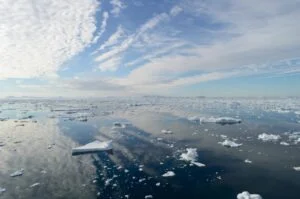
Why in News?
- The recent news about a persistent ozone hole over Antarctica raises concerns about the long-term health of the Southern Hemisphere’s ecosystems.
- While the ozone layer, Earth’s shield against harmful ultraviolet (UV) radiation, has shown signs of recovery in the past two decades, a recent study highlights a worrying trend – a prolonged depletion period that coincides with critical biological activity in Antarctica.
The Importance of the Ozone Layer
- High above us lies the ozone layer, a vital part of the stratosphere that absorbs most of the sun’s harmful UV radiation, particularly the harsh UV-B rays.
- This invisible shield protects life on Earth from the damaging effects of UV radiation, which can cause skin cancer, cataracts, and harm plant and animal life.
The Threat of Depletion
- Human activities are jeopardizing a vital atmospheric layer that safeguards life on Earth from harmful ultraviolet (UV) radiation.
- Chlorofluorocarbons (CFCs) and other ozone-depleting substances (ODS) used in various applications like cooling systems, spray cans, and industrial processes interact with UV rays, causing the breakdown of critical molecules in this protective layer.
- This breakdown creates a thinning area, particularly concerning over Antarctica – a region now infamous for this vulnerability.
The Montreal Protocol: A Beacon of Hope
- The world recognized the urgency of this issue in 1987 with the signing of the Montreal Protocol, a landmark international treaty. This agreement aimed to phase out the production and consumption of ODS.
- The success of the Montreal Protocol is a testament to international cooperation.
- All 197 UN member states have ratified the treaty, a historic first. The impact has been significant, with a reduction of over 90% in the atmospheric concentration of key ODS since its implementation.
The Antarctic Ozone Hole: A Persistent Threat
- Despite the positive trajectory, the recent study in Global Change Biology sounds an alarm.
- While this hole has shrunk over the past 25 years, the depletion has persisted for an unusually long duration in the last four years.
- This extended period of vulnerability coincides with the beginning of the austral summer, a critical time for Antarctic life.
Consequences of Extended Ozone Depletion
- The prolonged depletion allows high levels of UV-B radiation to reach the Earth’s surface during the austral summer.
- This period coincides with snowmelt, the emergence of vegetation, and the breeding season for many Antarctic animals.
- Increased UV-B exposure can have devastating consequences, harming plant and animal life during these vulnerable stages.
The Road to Recovery
- The good news is that this layer is expected to recover gradually over the coming decades, with the Antarctic ozone hole projected to disappear by the 2060s.
- However, continued monitoring and research are crucial to understand the full impact of past depletion and to mitigate future risks.
Looking Forward: Continued Vigilance
- The Montreal Protocol stands as a model for international cooperation in addressing environmental challenges. However, our work is not done.
- Continued research is needed to fully understand the long-term effects of ozone depletion on Antarctic ecosystems. International cooperation remains vital to ensure the continued success of the Montreal Protocol and to safeguard the fragile ecosystems of the Southern Hemisphere.
- By staying informed and committed to environmental protection, we can ensure a healthy ozone layer and a brighter future for life on Earth, including the unique and irreplaceable ecosystems of Antarctica.
People also ask
Q1: What is the ozone layer?
Ans: This layer is a region in Earth’s stratosphere that absorbs most of the sun’s harmful ultraviolet (UV) radiation, particularly UV-B rays. It acts as a protective shield for life on Earth.
Q2: What causes ozone depletion?
Ans: This depletion occurs when chlorofluorocarbons (CFCs) and other ozone-depleting substances (ODS) used in refrigerants, aerosols, and industrial processes interact with UV rays, breaking down ozone molecules.
Q3: What is the Antarctic ozone hole?
Ans: High above Antarctica, a vast region in the atmosphere has become thinner and more vulnerable. This area, formed during the Southern Hemisphere’s spring (September to November), is a consequence of frigid temperatures and unique cloud formations called polar stratospheric clouds.
Thanks for sharing. I read many of your blog posts, cool, your blog is very good.
Thank you so much for your comments you can share with your friends and also who prepered for compittive exam.